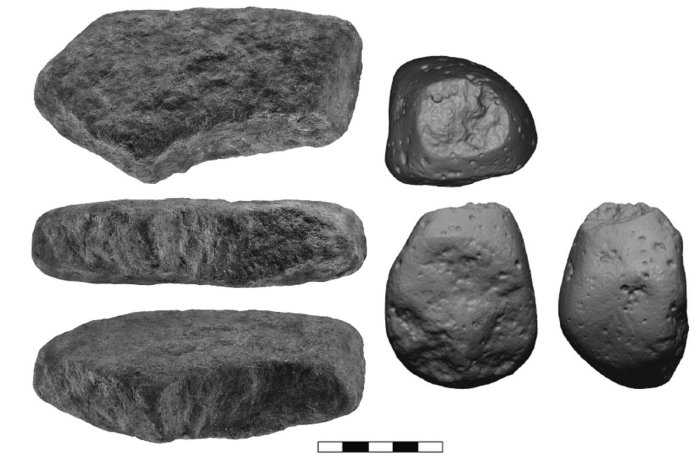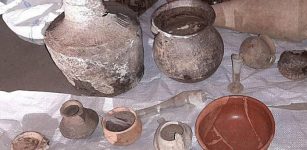Archaeological Finds Shed New Light On The Paleo Diet Habits Of Ancient Hunter-Gatherers
Jan Bartek - AncientPages.com - A recent archaeological study conducted along the Jordan River banks, south of northern Israel's Hula Valley, provides new insights into the dietary habits of early humans, challenging traditional views on prehistoric diets.
The research indicates that ancient hunter-gatherers heavily relied on plant foods, particularly starchy plants, as a primary energy source. Contrary to popular belief that early hominid diets focused mainly on animal protein, this study reveals a diverse range of plant-based foods in their diet, including acorns, cereals, legumes, and aquatic plants.
A stone anvil (left) and hammerstone (right) used for processing plants. Credit: Gesher Benot Ya'akov team
The multidisciplinary research centers around the discovery of starch grains approximately 780,000 years old from basalt tools at an ancient settlement site near Gesher Benot Ya'akov. This site has yielded extensive evidence, including over 20 settlement layers and fossilized remains. The findings challenge the prevailing notion that ancient human diets were primarily animal-based—a view often supported by interpretations from animal bones found at archaeological sites where plant remains are rarely preserved.
Excavations at Gesher Benot Ya'akov. Credit: Gesher Benot Ya'akov team
The study was conducted as part of Dr. Hadar Ahituv's doctoral thesis at Bar-Ilan University's Martin (Szusz) Department of Land of Israel Studies and Archaeology. He is now at the Laboratory for Ancient Food Processing Technologies (LAFPT), at Haifa University's Zinman Institute of Archaeology. This collaborative research effort also involved scholars from multiple institutions, including Prof. Nira Alperson-Afil and Dr. Yoel Melamed from Bar-Ilan University, Prof. Naama Goren-Inbar from the Hebrew University, and Prof. Amanda Henry from Leiden University, Netherlands.
The presence of starch grains on ancient tools highlights the significant role plants played in early human diets. These grains suggest that starchy tubers and nuts rich in carbohydrates were crucial for meeting the energy demands required by the human brain. The study also underscores sophisticated methods used by early humans to process plant materials; starch grains were discovered on basalt maces and anvils used for cracking and crushing various plants.
Examples of some of the plants recovered from Gesher Benot Ya'akov percussive tools, including both the whole plant, the edible part, and the characteristic starch grains. From left to right: oak, yellow water lily, and common oat (scale is 20 µm). Credit: Dr. Hadar Ahituv and Dr. Yoel Melamed
Additionally, microscopic remains such as pollen grains support these findings' credibility. This research offers insights into social behaviors among early humans; tool use for processing plants implies cooperation within larger social groups and a deep understanding of their environment similar to modern humans today.
This discovery marks an important milestone in prehistoric studies by providing valuable evidence about our ancestors' dietary habits while offering fresh perspectives on human evolution and societal development.
See also: More Archaeology News
"This discovery underscores the importance of plant foods in the evolution of our ancestors," said Dr. Ahituv. "We now understand that early hominids gathered a wide variety of plants year-round, which they processed using tools made from basalt. This discovery opens a new chapter in the study of early human diets and their profound connection to plant-based foods."
The study was published in the Proceedings of the National Academy of Sciences
Written by Jan Bartek - AncientPages.com Staff Writer
























